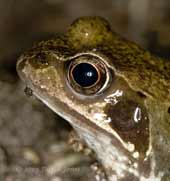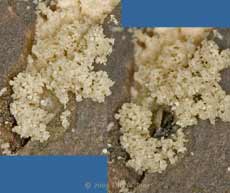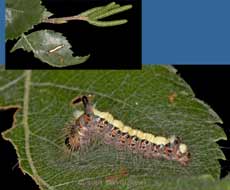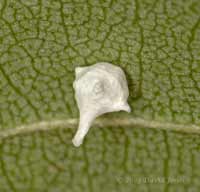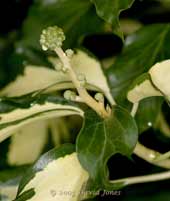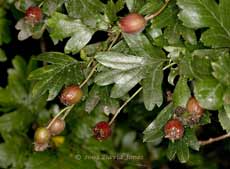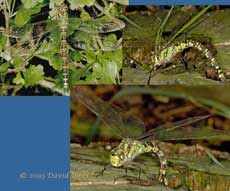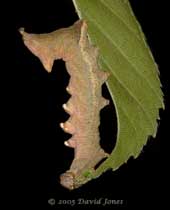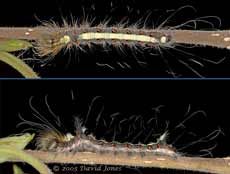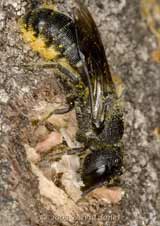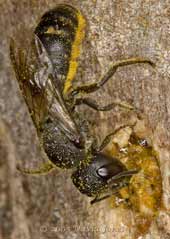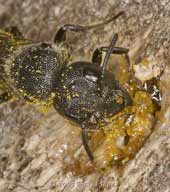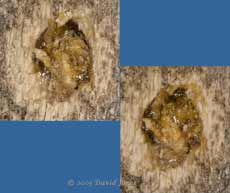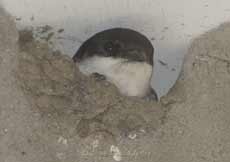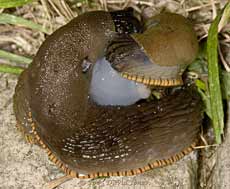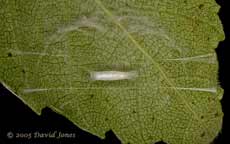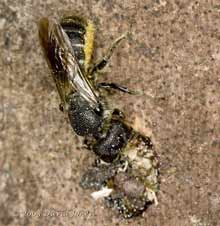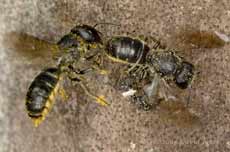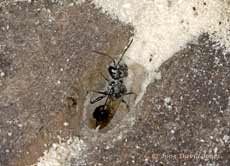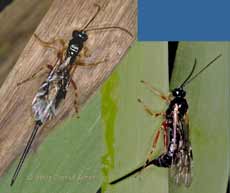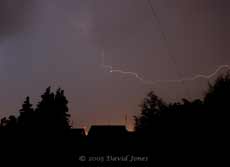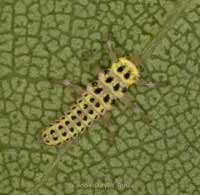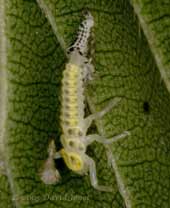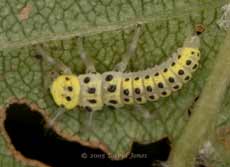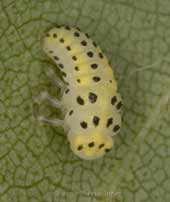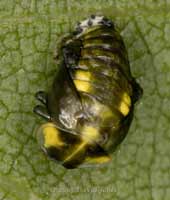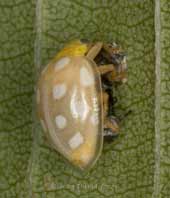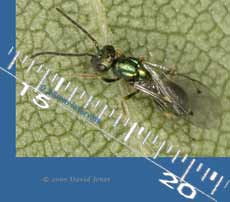Go to the last entry on this page .....Go to previous entry19 August - What a difference between two mornings. After yesterday's very warm and humid day, this morning we woke up to heavy rain and much cooler temperatures, although not so cool that it prevented us from having breakfast on the veranda where we played 'spot the frog' as we ate our toast! Many thanks to Roy and Marie Who were faster off the mark than me this morning in identifying yesterday's moth as a 'Yellow Shell' Geometer Moth (Euphyia bilineata). Roy and Marie have about 2 acres of land that they are turning into woodland, with ponds and meadow area to encourage wildlife - I have enough of a challenge with my small space! This morning it has been good to see for Goldfinches at the feeder. We have had only occasional glimpses of them since the holiday. The rain turned to drizzle and by the late afternoon it was dry enough to get out into the garden with my camera.
These images show its rear end as it pushed out damp wood clips. Within the hour the hole was sealed once again. Again, I couldn't find any Orange Ladybird adults on the Birch, but I did find this caterpillar. A look through my caterpillar guide comes up with a possible match as Grey Dagger Moth caterpillar (Acronicta psi) which includes the Birch a one of its main food plants. Although the picture doesn't show it clearly, in the lower image the caterpillar is only holding onto the leaf with its claspers (at the rear end). The front of the body is supported by the dense covering of hairs.
Under another Birch leaf is this small (a couple of millimetres across) object. It resembles the galls I found on several rose leaves. However, I wonder if this one is in fact a spider egg case.
The cooler temperature has meant that the House Martins have appeared less at the nest entrance today. Even as they continue with their nesting,
at the bottom of the garden there is now one of the signals that indicate
that Autumn is not far away - The Ivy is covered with lots of developing
flower buds.
Nearer the house, the Hawthorn is also showing the way to Autumn as its berries turn to red.
I took that last picture at around 6pm, and as I did so I was distracted by the whirring sound of a dragonfly's wings. I looked down to see it hovering right next to me. I tried to get an 'in flight' shot but it wouldn't stay in one spot long enough, and it wasn't light enough for the camera to focus easily. However, it then surprised me by landing on an old stump under the shade of the Hawthorn to spend time finding a suitable place to start egg laying. It eventually settled on a hollow at the top of the log. I'm sure that it is a Southern Hawker, a species I have seen egg-laying here in the past, although then it chose the log in the middle of the pond. It looks as though I will need to move this stump to a spot in or next to the large pond in the near future, before the larvae hatch and want to head into water.
21 August - Another sunny day, although rain is forecast for tonight. Yesterday I did various jobs around the garden, including re-potting a large bamboo plant and clearing more of the old growth around the pond - I went on too long and am suffering the consequences today! I have revisited two of the caterpillars that I had photographed over the last week.
If you scroll back to the previous image (17 August) you will see how its colour has changed from a yellowish green to a reddish green in the last four days. I looked back at my original image files to make sure that I hadn't altered the colour of that first image.
These images are of the Grey Dagger Moth caterpillar. Although the first picture (on 19 August) showed that it is very hairy, its position this morning gave me a better opportunity to emphasise just how hairy it really is. The tips of the long hairs seem to be white, or perhaps they are slightly thicker than the lower parts.
23 August - After a thoroughly wet yesterday, this morning we awoke to blue skies again. First thing yesterday morning I took advantage of a pause in the rain to go down the garden to check on the caterpillars. While the Grey Dagger was (and still is this morning) continuing to munch its way through leaves, the Iron Prominent had left its grazing patch. A quick search was needed before I found it some way along the branch, heading in the direction of the trunk. It was now much darker in colour, nearly all brown. I dashed back to the house to get my camera but by the time I got back it had disappeared!!! I know that caterpillars can move quite quickly so I searched for a few minutes without any luck. Knowing that this species pupates underground I dropped a small piece of wood from where I last saw the caterpillar and searched the ground around its point of impact without luck. Then the rain returned. This morning, another check revealed nothing. I had an interesting e-mail yesterday concerning the solitary bees that I photographed on 15 August. They may be a 'Red Data Book' species, Heriades truncorum (Daisy Carpenter Bee), which would mean that they rare in the UK - I await confirmation or otherwise on that before I get too excited.
On the basis of that e-mail I spent some time today watching the bees again. There were perhaps six still active and I took some photographs of two. This first one was busy adding wood chips, obtained from an unused hole, to the seal on its nest.
This second bee was still working on completing the basic sealing of its nest hole. It is quite difficult to get a decent image as the bee is almost continuously rotating around the hole as it works on the seal.
This close-up shows it chewing at the 'resin' which appears to have wood chips embedded in it.
Finally, two images of the hole. The left hand image was taken at mid-day, and the right one around 6pm. The bee was active for most of the afternoon just sealing the last bit. I should point out that the area of light coloured wood around the hole was not produced by the bee, but by the chuck of the drill I used.
We only saw one leaf-cutter bee active today.
The only activity seen was when there was a 'change of shift' between the pair, or when one looked out, presumably looking and listening for its partner.
In the garden, bird activity really is at a low at the moment, with just half a dozen Sparrows, a Blue Tit and a juvenile Blackbird seen feeding here all day.
24 August - A dull, wet and quite cool day, so not much prospect photographs today. However, there are a couple to add from last night, when I took a last stroll down the garden at around 11pm. We have more than our fair share of slugs in the garden, and I have to confess that I rarely photograph them, but this sighting last night had me using my camera.
I have yet to find a description of reproduction in this species so I can't give any more details at the moment.
I should have stayed around to watch but I'm afraid I needed to get to bed so I only took a few photographs, some of which you can see if you click on the image. A week ago I spotted this cocoon (or refuge?) under a leaf on the Birch tree, but have only just go around to looking at the images. The cocoon, measuring just over 4mm in length, is supported within quite a complex structure of threads. First of all, two multi-strand threads hold the sides of the leaf under tension so that it takes a concave shape. From one of these threads the cocoon is securely suspended above the leaf surface. There is also a crescent shaped protective(?) barrier on one side of the structure.
28 August - The nicest day of the last week, but I haven't been taking any photographs! I have been laid low by a flu bug these last few days so haven't been too interested in the outside-world. It's starting to ease up now so I hope to get out more tomorrow. Just a couple of things to note. First of all, the Grey Dagger caterpillar has now disappeared from the branches of the Birch. Yesterday it had moved from the branch it had been feeding on, but today it had completely vanished. Next, the solitary wasp last mentioned on 19 August is still busy in its burrow, with fresh sawdust appearing outside the burrow today. I am still waiting for news about the solitary bees, and today there were just a few active while the sun shone on their log. While we were having lunch outside a Sparrowhawk made an attack on the Sparrows in the Hawthorn. This was the first time I have seen a hawk here for ages.
29 August - Another perfect summer's day, with hardly a cloud in sight and very warm temperatures. The 'left overs' of the flu are still hanging over me but I did get out into the garden with my camera today.
The presence of pollen on them indicated that they are still able to find suitable flowers, although I didn't see any of them visit the few remaining Ragworts in the garden.
Occasionally there would be interaction between bees, when one bee, already working on a hole was 'buzzed by another bee which didn't land. There were numerous similar encounters between this pair while I watched. The aggressive bee had been going in and out of a hole very near to the sealed one, so perhaps it regarded this area as its territory? The funny thing about this picture is I must have tried to get the shot some twenty times, but usually reacted too slowly - this was my first attempt, and the rest were rubbish!
It was some twenty minutes before I took this shot as the wasp appeared from the burrow and flew off. Half an hour passed before it returned, and although I stayed another forty five minutes it didn't emerge before I headed to the veranda for lunch.
One of the frustrating things about having the camera mounted on a tripod is that (even with a quick release plate in use) you cannot always respond quickly enough to something unexpected. In this case, a large Ichneumon fly that flew about the Stinging Nettles as I waited for the wasp to reappear.
Before I headed back indoors to put my feet up for a while, I pointed the camera at one more insect that caught my eye as it flew amongst the plants by the big pond. This is a Sawfly of some sort, although the images in my insect guide don't seem to be very helpful.
The House Martins' behaviour still suggests that they are incubating eggs. It's now nearly a week later than the moment last year when we first saw faecal sacs being dropped from the nest.
The forecast spoke of thunder storms tonight, and this evening we have seen two pass to the west of us, although we have had very little rain so far.
Down the garden, there were still three or four solitary bees active today. Surprisingly, the solitary wasp didn't emerge from its log burrow until after mid-day. We haven't seen any leaf-cutter bees over the last three days so it looks as though their activities may be over for this summer.
Since then, adults have been seen only very occasionally. However, mating must have taken place as there are small numbers of larvae to bee seen on the Birch.
As each larva develops, every so often it needs to moult. This image shows a larva that has done just that, leaving its cast-off skin joined to the leaf.
This larva is nearly twice the size of the first one, measuring around 1cm in length. You can see how the spots are more spread out. It is close to the maximum size and will soon be ready to pupate.
That is what is happening here. This larva has attached its rear end to the leaf, curled its legs under its body, and is undergoing the major change from larva to pupa.
On another leaf is this fully formed pupa. At the top you can just make out the larva skin cast off as the pupa formed.
Finally, yesterday I found this newly emerged adult, still holding onto the pupal skin as it waited for its exoskeleton to harden. Today I could see no sign of this, or any other adults.
While searching for the Orange Ladybirds I came across another of those curious cocoon structures (see 24 August), and also this tiny insect with an iridescent green body. Measuring just over 3mm in length, I think it may be a gall wasp, although I can't match it with any of the pictures in my insect guides.
Click on the images to see larger versions - |
|
